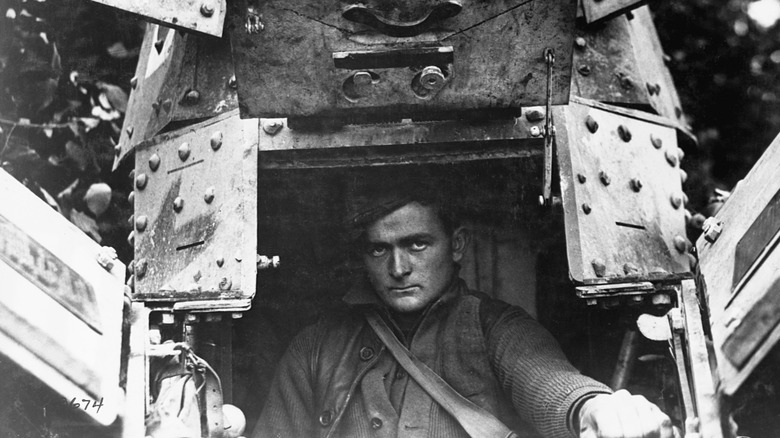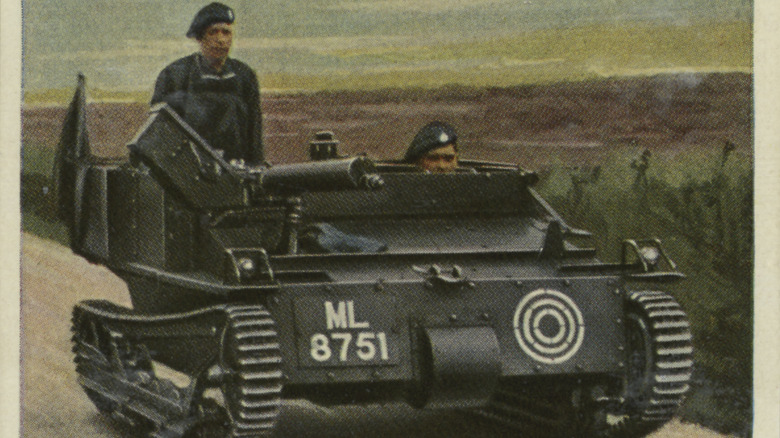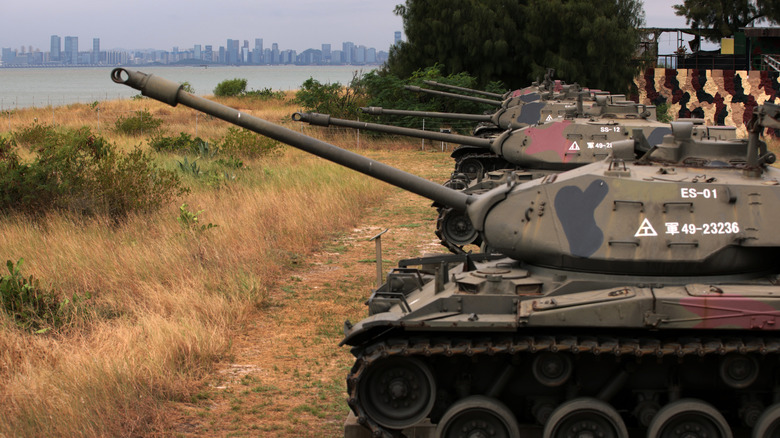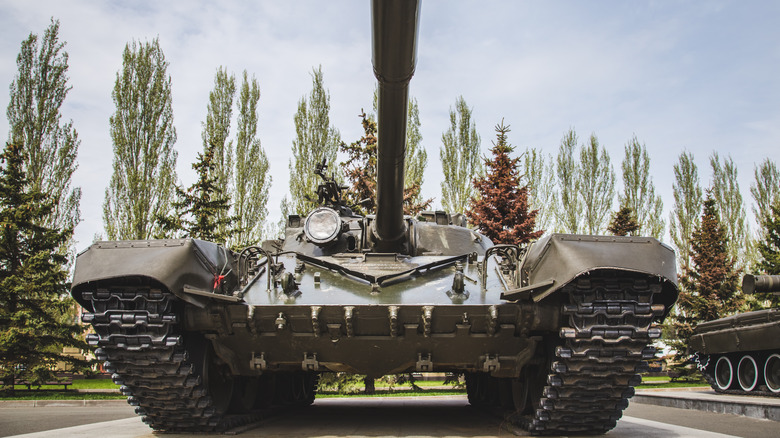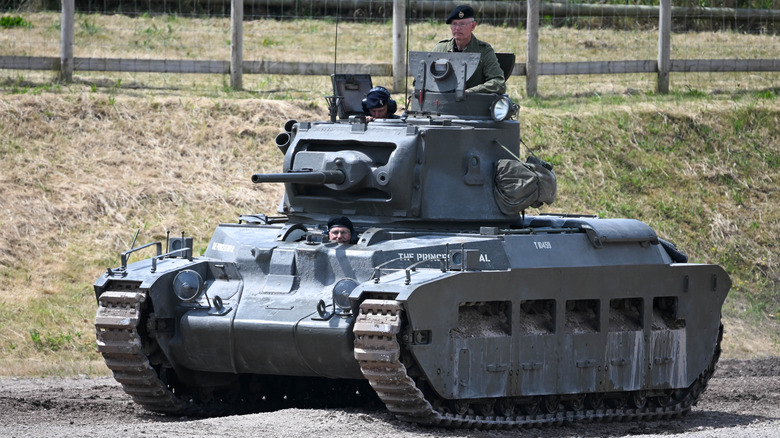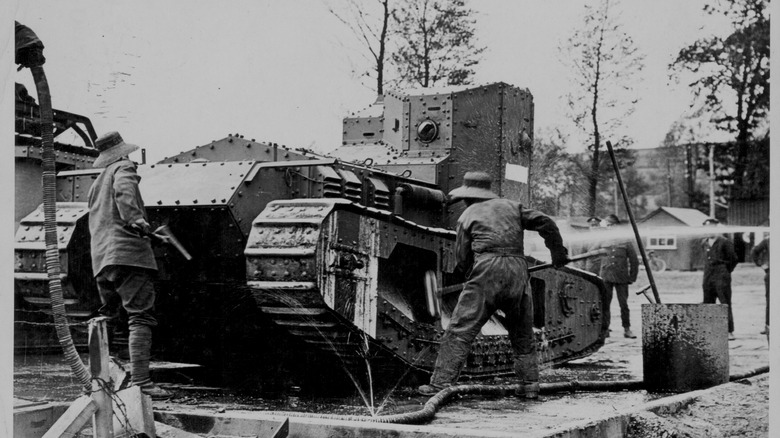5 Military Tanks That Are Much Smaller Than You Think
Typically, the word "tank" evokes images of enormous reinforced vehicles: heavily armored, heavily armed, and just plain heavy. Outside of its military applications, we might snarkily apply the word to a vehicle that seems unnecessarily oversized. In the world of video games, the phrase "tank controls" even refers to characters that are cumbersome to maneuver around.
Lots of tanks have been and continue to be built along these lines. Although it ended up being terribly impractical, the massive Panzer VIII Maus tank used in World War II weighed a whopping 188 tons. The very fact that a tank (albeit a silly prototype of one) was constructed that weighs almost as much as a blue whale (The majestic beasts can reach approximately 200 tons.) might make you wonder if, on the other side of the coin, surprisingly small and subtle tanks could also have been developed.
Well, they certainly have been. The light tank has long had a place in battle just as its more substantial MBT and heavy tank counterparts have. Here are some of the tiniest tanks the armies of the world have ever devised.
Carden Loyd Carrier, Mark VI
World War I marked the first widespread use of tanks in combat. They weren't the most elegant machines early in the conflict, but they would inspire the creation of the tanks that shaped the course of World War II, including the Blitzkrieg and the Stalemate.
One of these curious creations was the Carden Loyd Carrier, Mark VI. This version of the machine was created by Irish baronet Sir John Carden and former World War I captain Vivian Loyd. Approximately 270 of them were developed between 1927 and 1930. Technically, The Tank Museum historian David Fletcher notes in the museum's Tank Chats series, "It wasn't really meant as a tank, it was meant as a machine gun carrier for the infantry." Nevertheless, they sometimes served in the traditional role of a light tank in the first years after they started being produced. As lightweight vehicles, they helped the Royal Tank Corps perform experimental reconnaissance on Salisbury plain.
Its engine was a Ford Model T, and the British original also boasted a Vickers gun for the gunner to use. Although it stretched just 10.5 feet long and 6.6 feet across, there was enough space to fit a crew of two. Overall, it was a unique model that led to new innovations in maneuverability and firepower.
M41 Walker Bulldog
During World War II, the shortcomings of light tanks became clear. They were too small to equip with enough weaponry, and they also typically had less armor, rendering the occupants more vulnerable. Models such as the Locust were short-lived because of this, but engineers continued to design other light tank models that could stand up against competitors.
The M41 Walker Bulldog was one example. As LIFE reported in February 1951, the Bulldog began as the T-41, showcased for then-President Truman at the Aberdeen Proving Ground. Its gun, according to the magazine, was a "supervelocity 76mm," boasting "more armor-piercing power than the 85-mm gun in Russia's T-34 medium tank." With stability to match its potency, here was a light tank that really did seem to have a lot of practical power.
Developed at the Cleveland Tank Plant by Cadillac, it featured a 500 horsepower AOS-895-3 supercharged engine with firepower rounded out by two weighty machine guns and explosive, armor-piercing rounds. Though unable to withstand shots from other tanks, it had a lot of power and pace (capable of 45 mph travel), all wrapped up in a surprisingly diminutive package. Weighing in at 25.9 tons, the M41 Walker Bulldog was 10.5 feet wide and about 27 feet long. The U.S. considered the T-41 to be "the world's best light tank," according to LIFE. However, it ultimately become more of an export model.
T-60
The manufacturing might of the Soviet Union saw huge numbers of tanks developed during World War II. Indeed, it was in part the weight of numbers that proved decisive in the Soviets' ability to ultimately withstand the German invasion and (at shocking cost to both sides) survive Operation Barbarossa. In the conflict, the formidable medium Soviet T-34 tank was a key weapon in the Soviet arsenal, but tanks of various other shapes and sizes were also deployed. The T-34, at approximately 26.5 tons, was a relatively modest weight for a medium tank. (The famed Sherman weighs over 30 tons in comparison.) The T-60, meanwhile, would barely register on the scales beside them.
The T-60 was born earlier in the German invasion, in July 1941. Soviet Resolution No.222ss called for something that could be quickly and efficiently developed in great numbers to aid in defense: namely, light tanks. The T-60 developed from improvements made to the hastily-built prototype model, and 6,292 of them would ultimately be completed. With a 20mm gun and top speed of about 27 mph, the T-60 was serviceable in tank combat only for a brief period before the Soviets stopped making it.
This plucky little model, just 5.7 feet tall and 6.4 tons in its revised design, was only in production for 10 months. Nonetheless, it paved the way for the pivotal Soviet tanks to come.
Matilda II
The British have developed some truly hardy tanks, such as the UK's Challenger 2 tank. The Churchill, similarly, would become quite the menace in later guises, with its thick shell becoming rather difficult to penetrate. Defensive capabilities can be invaluable in tanks for obvious reasons, but a vehicle doesn't ultimately count for much if it can't bring considerable firepower to the table, too.
Britain's original Matilda tank, the A11, was just one more model with unfortunate limitations in this regard. "It was done down to a price ... and the price was ridiculously low," The Tank Museum's David Fletcher reported. Its armor, up to 60mm, was all but impenetrable around 1940 when the tank was used. Armed only with Vickers or other similar machine guns, though, Fletcher deemed them "almost toothless, useless little things." The subsequent model, the mighty Matilda II infantry tank, would be anything but.
The Matilda II, developed by the British Vulcan Foundry, started to arrive in late 1939. A predominantly cast steel body, with protection as thick as 78mm, was paired with a two-pound gun. As The Tank Museum curator David Willey concluded, "This is the tank that caused Hitler to worry when he reads reports [of] 37mm anti-tank guns bouncing off this thick armor." As with the Walker Bulldog, the Matilda II was a relatively modest package for a four-crew tank, at 26.9 tons, 18.4 feet long, and 8.25 feet tall.
Whippet
A "whippet" by definition is an adorable speedy dog that is generally of slight build. Late in World War I, 8 mph was considered a groundbreaking pace for a tank, and the nickname of Whippet was granted to the British Medium Mark A tank when it debuted in early 1918.
Tanks, in a broader sense, had been used for around a year and a half at the time of its introduction, and the time had come to try and develop some more sophisticated tactics with them. The original model, the Mark I, could hit only 3.7 mph, meaning that quick tactical adjustments to fluid battlefield situations were far too much to ask of such a machine. The faster-moving Whippet, though, sported considerable power and shock value, to the extent that historian David Fletcher commenting that "at the end of the war, these tanks were as useful as the heavy tanks for attacking German positions."
With 14mm shielding, the Whippet didn't compare to some of the other tanks on this list defensively. However, the Whippet boasted four Hotchkiss guns, making them potent weapons before more formidable cannons were developed. The 14-ton tank was a tight squeeze for the three crew members, however.
